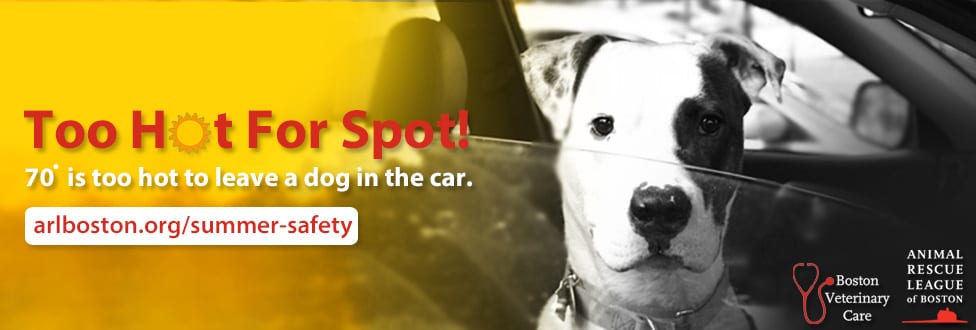Summer Situations May Be TOO HOT FOR SPOT
The Animal Rescue League of Boston (ARL) shares advice all summer long on how to keep your pet safe in the warmer months
After a long [record-breaking] snowy Winter in New England, Summer is finally upon us! We’ve been waiting a long time for sunny and warm weather, so we’re all understandably eager to spend as much time as possible with our two-legged and four-legged family members and friends enjoying the outdoors.
Just as we humans protect ourselves from the sun and elements with sunscreen, hats, bug repellant, and staying hydrated in the hot sun, our pets need that kind of protection too.

Never leave your pet alone in a parked car on a warm day- even with the windows cracked. It’s just TOO HOT FOR SPOT!
When temperatures begin to rise, so do concerns about animal safety.
Even when temperatures dip below 80 degrees, the threat for heat stroke still exists. Remember that pets don’t sweat the way humans do, making them unable to cool their bodies efficiently in the heat.
From July through September, our Too Hot For Spot public education campaign will offer a series of tips on how to keep your pet safe throughout the summer.
Keep your furry family members healthy by following these important basic guidelines:
- Prevention is always your best bet. Whenever possible, leave your pet at home in a cool humidity- and temperature-regulated room.
- If your pet must be outdoors, find a shady spot with ample air flow to prevent overheating.
- Hydration is key. Keep a bowl of cold water accessible at all times.
- Limit exercise to the morning or evening hours when temperatures are at their coolest.
- Never leave your pet alone in a parked car—even with the air conditioner on or the windows cracked. On an 85 degree day, the temperature inside a car can rise above 100 degrees in less than 10 minutes, which is why it is the most common cause of deadly heat stroke. It’s just too hot for Spot!
If you suspect that your pet is suffering from heat stroke, seek immediate medical attention from a veterinarian.
Common symptoms of heatstroke in dogs and cats include: heavy panting, glazed eyes, a rapid heartbeat, difficulty breathing, excessive thirst, lethargy, fever, dizziness, lack of coordination, profuse salivation, vomiting, a deep red or purple tongue, seizure, and unconsciousness.
For more warm weather pet safety tips, visit arlboston.org/summer-safety

